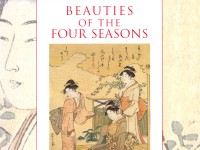Beauties of the Four Seasons
A full catalogue of the Ashmolean’s collection of Japanese bijinga (beautiful women) prints by Mitsuko Watanabe (published Oxford, 2005).

Publications online: 54 objects
Cherry blossom viewing at Mount Asuka
-
Literature notes
Torii Kiyonaga, who was born into a book-seller family, was a pupil of Torii Kiyomitsu (1735-85) and later became the fourth Head of the Torii School of artists. In his earlier works, the influences of Suzuki Harunobu and Isoda Koryūsai can be seen, but Kiyonaga established his own style during the Tenmei era (1781-9). The beauties of this new style were innovatively naturalistic figures with small heads, tall and slender, but the outdoor scenery behind the figures was usually extensive and drawn in geometric perspective. He frequently used multiple sheets of ōban to form a diptych or triptych, thus illustrating whole scenes.
This print is a centre sheet of a triptych. It depicts scenery of Mount Asuka, famous even today for its cherry blossom viewing. A lady with a splendid straw hat and a black kimono, and her maid who holds a pipe, are probably having a walk in late spring. In the background, there is a party going on under the cherry tree and a lady holding a telescope can be seen in the distance.
The cherry blossoms would originally have been pinker but have slightly faded in this print. -
Details
- Associated place
- Date
- c. 1785
- Artist/maker
-
Torii Kiyonaga (1752 - 1815) (designer)
- Material and technique
- nishiki-e (multi-block) woodblock print, printed with water-based vegetable pigments
- Dimensions
-
mount 55.7 x 40.6 cm (height x width)
print 37.6 x 24.3 cm (height x width)
- Material index
- Technique index
- Object type index
- No. of items
- 1
- Credit line
- Presented by Mrs Allan and Mr and Mrs H. N. Spalding, 1952.
- Accession no.
- EAX.4078
-
Further reading
Oxford: Ashmolean Museum, 24 August-30 November 2005, Beauties of the Four Seasons, Mitsuko Watanabe, ed. (Oxford: Ashmolean Museum, 2005), no. 5 on p.10, illus. p. 11
Glossary (2)
nishiki-e, vegetable pigments
-
nishiki-e
Nishiki-e literally means 'brocade pictures' and refers to multi-coloured woodblock prints.
-
vegetable pigments
Vegetable pigments were used to create coloured dyes for Japanese prints, paintings, and textiles. These pigments often faded over time due to the chemical reactions they underwent.
Location
-
- currently in research collection
Objects are sometimes moved to a different location. Our object location data is usually updated on a monthly basis. Contact the Jameel Study Centre if you are planning to visit the museum to see a particular object on display, or would like to arrange an appointment to see an object in our reserve collections.
Publications online
-

Beauties of the Four Seasons
Torii Kiyonaga, who was born into a book-seller family, was a pupil of Torii Kiyomitsu (1735-85) and later became the fourth Head of the Torii School of artists. In his earlier works, the influences of Suzuki Harunobu and Isoda Koryūsai can be seen, but Kiyonaga established his own style during the Tenmei era (1781-9). The beauties of this new style were innovatively naturalistic figures with small heads, tall and slender, but the outdoor scenery behind the figures was usually extensive and drawn in geometric perspective. He frequently used multiple sheets of ōban to form a diptych or triptych, thus illustrating whole scenes.
This print is a centre sheet of a triptych. It depicts scenery of Mount Asuka, famous even today for its cherry blossom viewing. A lady with a splendid straw hat and a black kimono, and her maid who holds a pipe, are probably having a walk in late spring. In the background, there is a party going on under the cherry tree and a lady holding a telescope can be seen in the distance.
The cherry blossoms would originally have been pinker but have slightly faded in this print.
Notice
Object information may not accurately reflect the actual contents of the original publication, since our online objects contain current information held in our collections database. Click on 'buy this publication' to purchase printed versions of our online publications, where available, or contact the Jameel Study Centre to arrange access to books on our collections that are now out of print.
© 2013 University of Oxford - Ashmolean Museum

